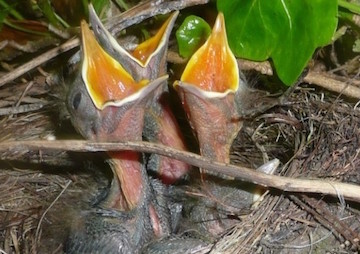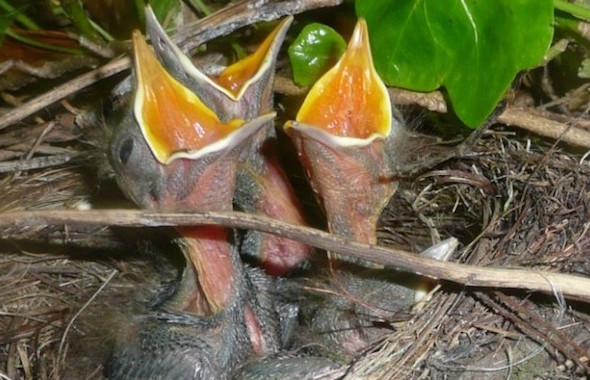Climate Change Disrupts Wildlife Schedule
The largest ever study of how climate sensitivity manifests itself in the seasonal behavior of U.K. plants and animals warns that some species may struggle to survive.
By Tim Radford / Climate News Network

Hungry blackbird chicks rely on plentiful insects for their parents to catch. (Dennis@Stromness via Flickr)
This piece first appeared at Climate News Network.
LONDON — In a warming world, in which spring arrives ever earlier and rainfall patterns shift, some species may not be able to cope with change.
A major scientific survey warns that plants may flower before insects are ready to pollinate them, and the birds that time their nest cycles to the season for insects might find their prey in short supply.
Scientists in the UK have just published the largest ever study of ecosystems and the changes in the seasons. They report in Nature journal that a consortium of researchers from 18 organisations combed the literature to identify more than 10,000 data sets, containing 370,000 observations of seasonal events in the natural world.
Their search spanned the years 1960 to 2012, and involved 812 plant and animal species from the seashore, the rivers and lakes, and dry land.
Different responses
The study embraced three vital levels of the food chain: the primary-producer plants and algae that turn sunlight and carbon dioxide into food; the primary-consumer birds and insects that eat the plants and their seeds; and the secondary-consumer birds, fish and mammals that dine on the insects.
They also looked at national temperature change and rainfall data over the period. And their conclusion is that plants and animals differ in their response to climate change, and that creatures at different levels of the food chain differ yet again.
And they forecast that, overall, the primary consumers will have shifted their seasonal timing more than twice as much as the primary producers and the secondary consumers. By 2050, the primary consumers will be at work an average of 6.2 days earlier, whereas the other two groups will have moved forward more than 2.5 days, but less than three.
“This is the largest study of the climatic sensitivity of UK plant and animal seasonal behaviour to date,” says the lead author, Stephen Thackeray, a lake ecologist from the UK Centre for Ecology and Hydrology.
“We are lucky in the UK to have a long history
of people fascinated with observing
and recording events in nature.”
“Our results show the potential for climate change to disrupt the relationships between plants and animals, and now it is crucially important that we try to understand the consequences of these changes.”
In nature, timing is everything, and the study rests on a low-key, quietly-observed science called phenology — the record of when things happen in the natural world.
Foresters, gardeners, growers and ornithologists have been recording the dates of such things as first bud, first leaf, first nesting behaviour, first butterfly emergence since the 19th century, largely as a labour of love.
But it became clear two decades ago that such observations had begun to confirm the reality of climate change even more forcefully than slight shifts in the mercury of the thermometer. The evidence was in the form of milder winters, longer growing seasons, and earlier foliage in particular.
Winners and losers
The long-term consequences of global warming remain uncertain. Researchers have recorded slower growth in the giants of the forest, shifts in the distribution of plants, and changes in mountain meadow wildflowers. There is evidence that creatures can adapt, but there must be losers as well.
Right now, nobody can predict who the winners and losers will be. But disturbance to ecosystems must have consequences, and the latest research is just that — an attempt to frame the big picture for further observation. And it rests on a century of naturalist record-keeping.
One of the report’s authors, Deborah Hemming, a climate risk analyst at the UK Met Office, says: “We are lucky in the UK to have a long history of people fascinated with observing and recording events in nature.
“By quantifying the relationships between these phenological records and climate data across the UK, we identify many phenological events that are extremely sensitive to climate variations.
“These provide ideal early indicators, or sentinels, for monitoring and responding to the impacts of climate variability and change on nature.”
Tim Radford, a founding editor of Climate News Network, worked for The Guardian for 32 years, for most of that time as science editor. He has been covering climate change since 1988.
Your support matters…Independent journalism is under threat and overshadowed by heavily funded mainstream media.
You can help level the playing field. Become a member.
Your tax-deductible contribution keeps us digging beneath the headlines to give you thought-provoking, investigative reporting and analysis that unearths what's really happening- without compromise.
Give today to support our courageous, independent journalists.






You need to be a supporter to comment.
There are currently no responses to this article.
Be the first to respond.